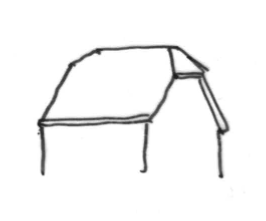The roof of a house performs an important protective function and is therefore judged primarily in terms of its functionality. However, when choosing the shape of the roof must also take into account aesthetic aspects, because it gives the house a certain character. Ultimately, no other structural element affects the overall appearance of the house as much as the roof. Of course, the development plan also has a say in the shape of the roof. In the case of extravagant roof shapes (or those that stand out from the neighborhood development pattern), the builder must first consult the development plan or submit a preliminary building application. In this article you will find all the main forms of roofs, along with their specific characteristics.
the essentials in brief
- Different roof shapes have different advantages and disadvantages. There is no such thing as the best roof across the board.
- For example, consider the extent to which a particular roof shape limits or expands usable space. A hip roof restricts the space compared to a gable roof, while a monopitch roof opens up completely new possibilities.
- The roof primarily performs a protective function. In addition, it can be used to generate electricity – the installation of photovoltaic systems should be planned well in advance, as this also depends on the orientation and the angle of inclination of the roof.
The gable roof
When you think of a roof, the first thing that probably comes to mind is the shape of a gable roof. This is because it is the most common roof shape in Germany, and thus shapes entire regions. A gable roof is stable and requires comparatively little maintenance. The angle of inclination of the gable roof varies depending on the requirements situation. For example, a steep slope angle is useful in very rainy regions, as it allows the rain to drain off better. A somewhat flatter angle of inclination is used more in regions with high snow accumulation: the sliding down of the snow is more controlled this way. The timeless shape of the gable roof can be helped a bit by installing skylights or dormers, also they are available with or without overhang. Architects offer a range of modern designs and combinations. In addition, photovoltaic systems can usually be well installed. By the way, for a gable roof is first built the roof truss in the so-called construction of a wooden rafter or purlin roof, which is then covered. This design is also used for other sloped roofs with a slope of 30 degrees or higher. Roofing is possible with various roofing materials (e.g. roof tiles, roof stones). Due to the different eaves heights and angles of inclination, the gable roof has the following subcategories:
- Flat gable roof with roof pitch less than 30 degrees
- Angled roof (New German roof) with a roof pitch over 45 degrees
- Gothic roof (Old German roof) with a roof pitch above 62 degrees
- Old Franconian roof (old French roof) with a roof pitch of exactly 60 degrees
- Symmetrical gable roof, where both roof surfaces are the same length
- Asymmetrical gable roof, where one roof surface is longer than the other
From the frying pan into the eaves: eaves point and eaves height
The eaves are the lower edge of the roof where rainwater drains away. The length of the eaves is therefore equal to the width of the roof surface. Rain gutters are installed here. The point of intersection between the vertical exterior wall and the slope of the roof is called the eave point. Eave height, on the other hand, is the height between the eave point and the ground. Provisions on the eaves height can be found in the development plan, e.g. sometimes the eaves height can be linked to the roof pitch there: 3.5 m for a 45 degree roof pitch or 4 m for a 35 degree roof pitch.
The flat roof
Flat roofs lie flat on the house. The typical house form for the flat roof is the bungalow. Flat roofs have a slope angle of 10 degrees or less degrees (the lowest slope angle is 1 degree). They have a persistent reputation for being leaky. Of course, this cannot be generalized at all. But in fact, a flat roof should be processed according to the best quality standards. And high-quality waterproofing and good design for drainage are particularly important in the flat roof. This is because the rain can only drain slowly or sometimes overwhelms the structure for drainage. In addition, a flat roof is exposed to above-average weather conditions. Because sun or even hail always hit the roof directly, without there ever being an averted side. In any case, the flat roof is high maintenance for these reasons. With good workmanship and maintenance, the wetness then naturally stays outside. Photovoltaic systems never rest on flat roofs because they require an angle of inclination (in Germany, 30 to 36 degrees is optimal). So, if photovoltaic systems are to be installed on a flat roof, they need a support device.
Tip: The flat roof offers a usable space on the roof: why not simply create a roof terrace or plant a green roof. Creative lighting options can also be integrated in the form of light domes. With scarce land in cities, a flat roof also provides space for an organic vegetable garden, and in fact, such uses are becoming increasingly popular.
The shed roof
Actually, a pent roof is half a gable roof. In the past, monopitch roofs were mainly used for warehouses and factories, but today they also decorate many residential buildings. The monopitch roof does not enjoy increasing popularity for nothing, because it can keep up in the race with the other roof forms and even leads the field in certain points. The monopitch roof usually requires little maintenance. It can be covered with almost any material (eg, roof tiles, bitumen layer, slates, metal) and is immune to all weather conditions, because rainwater can drain perfectly. In addition, the monopitch roof allows you to realize a variety of creative possibilities. The usable space can be expanded in the process. It depends on the angle of inclination: The lower, the more space is gained. There is always plenty of usable space on the ridge side, which can be used for special features such as an open gallery. The free gable wall can be used for generous window areas. Often today you can see staggered and staggered monopitch roofs. Such double-pitch roofs can be explored in many modern architectural houses. Creative architects probably also like the monopitch roof because they can be used to design particularly large and bright rooms. A monopitch roof is suitable for the installation of photovoltaic systems. The optimal orientation of the monopitch roof is important: Usually pent roofs are aligned to the weather side (northwest side), but for an efficiently working photovoltaic system the sun side (south side) should be chosen.
The trailing roof
The trailing roof is a form of gable roof with an enlarged roof area. Under the wings of this roof can also accommodate attachments, such as a carport. One knows tow roofs mainly from old farms. However, they can also be found sporadically in residential neighborhoods. The trailing roof has a high aesthetic appeal and is an eye-catcher in any case, yet it is rather rare and is considered unfashionable.
The hip roof
The hipped roof is the historical roof par excellence, which is still popular today. In shape it resembles the gable roof, but has beveled gable surfaces. Thus, it has four sloping sides and four eaves. Since it signals distance on all sides, it usually looks very distinguished.
Hipped roofs make sense from a structural point of view, especially in difficult weather conditions, because the beveled gable surfaces take away the wind’s attack surface on the gable side as well. Also, with a hip roof, the gutters run all the way around the house, effectively keeping moisture away from the walls of the house. The clear disadvantage of such a four-sided sloping roof is obvious: the usable space of the attic is limited.
The cripple hipped roof
The cripple hip roof is considered the modern variant of the hip roof. In it, the gables are not completely hipped as in the hipped roof, but only partially. Possibly the distinguished character of the hipped roof is lost a little with this, as the flanks of the front and rear are opened up again a little.

The advantages of the modern variant are that the usable space is reduced less, and the optimal protective function of this roof structure is still maintained. It is then possible to install additional windows in the gables of the cripple hipped roof, so that the upper room of the house is provided with optimal lighting.
The mansard roof
The mansard roof is the noble roof of the old buildings. Its construction comes from the Baroque period in France. The mansard roof has roof slopes with different inclinations, i.e. the roof surface between the eaves and the ridge is broken parallel to the eaves, with the lower surface having a steeper inclination. Thus, it is actually a two-part gable roof. This design ensures optimal use of the attic. However, the mansard roof is a complex construction, which causes comparatively high costs. Compared to the gable roof, it is also considered less stable, since roof surfaces with different angles of inclination bring static disadvantages. Nevertheless, they can also be found on newer buildings. Lovers of the special or French Baroque should consider them anyway.
The mansard roof as an architectural tax saving trick
It is worth taking a look at the history book here: Once upon a time in Paris, a property tax was demanded for every floor. However, the attic was not considered to be fully usable and was therefore not affected by this tax. The architects François Mansart (1598- 1666) and his great-nephew Jules Hardouin-Mansart (1646-1708), after whom this roof form was named, therefore designed a roof form that made the attic fully usable – an architectural tax-saving trick, so to speak. Inventiveness is what counts!
The tent roof
The tent roof is often found in the Mediterranean region (e.g. Tuscany), but is also becoming increasingly popular in Germany. Similar to the hip roof, the tent roof has four sloping covered sides. The decisive difference, however, is that the slopes do not converge in a ridge as in a hip roof, but in a ridge point as in a pyramid.
The tent roof impresses with its symmetry. It is installed only on square (or nearly square) layouts. The four roof surfaces have the same slope, which can be different. If the slope is very shallow, water drains less well and snow also stays longer. If the angle of inclination is less than 22 degrees, an additional substructure is usually required to protect against moisture. Also, the type of tile corresponds to the angle of inclination: clay roof tiles are usually no longer used at an inclination below 10 degrees.
A photovoltaic system cannot develop efficiency if the slope is too shallow and then needs a support device. (The optimum angle of inclination for photovoltaic systems in Germany is 30 to 36 degrees). However, one thing is clear: the tent roof is one of the eye-catchers among the roof shapes.
The ridge
The ridge is the upper, usually horizontal edge of the roof. In round roof structures, such as the barrel roof, the apex is called the ridge. There is also ridge construction with positive or negative slope, in this case it is called rising or falling ridge.
The barrel roof
The barrel roof has the shape of a half barrel resting on the foundation. This roof shape was used as early as two centuries before Christ and is considered the oldest recorded roof shape ever. Due to the use of steel girders, barrel roofs were used in the 19th century for factory buildings and warehouses as well as wholesale market and exhibition halls, but also for railroad stations.
In modern residential buildings barrel roofs are still rather rare. This is also due to the fact that not every development plan allows them. At the same time, the soft and flowing shape of the barrel roof has a special aesthetic appeal: it is the only roof without corners and edges and without a classic ridge. A generous living space is created under the barrel roof: the attic is hardly restricted spatially and a very special homely atmosphere is created. Therefore, among lovers of unusual design barrel roof is very popular.
The barrel roof is also very stable, because all the forces are advantageously diverted to the outer walls. The construction is rather costly and therefore not the cheapest option. Bricks are not considered as roofing material, titanium zinc, stainless steel or copper are usually used.



